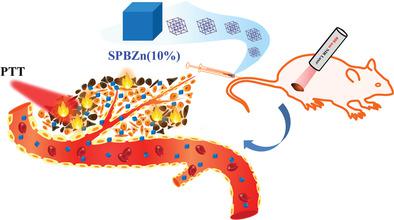当前位置:
X-MOL 学术
›
Adv. Healthcare Mater.
›
论文详情
Our official English website, www.x-mol.net, welcomes your
feedback! (Note: you will need to create a separate account there.)
Zn2+ Doped Ultrasmall Prussian Blue Nanotheranostic Agent for Breast Cancer Photothermal Therapy under MR Imaging Guidance.
Advanced Healthcare Materials ( IF 10.0 ) Pub Date : 2019-11-20 , DOI: 10.1002/adhm.201900948 Pingbo Shou 1 , Zhangsen Yu 1 , Yiting Wu 1 , Qiang Feng 1 , Bangyi Zhou 1 , Jie Xing 2 , Chuang Liu 2 , Jinqing Tu 1 , Ozioma Udochukwu Akakuru 2 , Zhiqiu Ye 1 , Xiaojuan Zhang 1 , Zhenbo Lu 1 , Luyun Zhang 2 , Aiguo Wu 2
Advanced Healthcare Materials ( IF 10.0 ) Pub Date : 2019-11-20 , DOI: 10.1002/adhm.201900948 Pingbo Shou 1 , Zhangsen Yu 1 , Yiting Wu 1 , Qiang Feng 1 , Bangyi Zhou 1 , Jie Xing 2 , Chuang Liu 2 , Jinqing Tu 1 , Ozioma Udochukwu Akakuru 2 , Zhiqiu Ye 1 , Xiaojuan Zhang 1 , Zhenbo Lu 1 , Luyun Zhang 2 , Aiguo Wu 2
Affiliation

|
Prussian blue nanoprobes are widely studied and applied in tumor photothermal therapy (PTT) and magnetic resonance imaging (MRI), due to their low toxicity and excellent in vivo performance. However, the sizes of hitherto reported Prussian blue nanoprobes are generally larger than 50 nm, which greatly influence cell phagocytosis, in vivo circulation, and biodistribution. In this work, a novel method of doping zinc ions is used to control the size of Prussian blue nanoprobes. Consequently, the performances of the nanoprobes in PTT and MRI are both significantly improved. The results show that the minimum size of Prussian blue nanoprobes achieved by doping 10% zinc ions (abbreviated as SPBZn(10%)) is 3.8 ± 0.90 nm, and the maximum specific absorption coefficient, photothermal conversion efficiency, and longitudinal relaxation rates are 1.78 L g-1 cm-1 , 47.33%, and 18.40 mm-1 s-1 , respectively. In addition, the SPBZn(10%) nanoprobes provide excellent PTT efficacy on 4T1 tumor cells (killing rate: 90.3%) and breast cancer model (tumor inhibition rate: 69.4%). Toxicological experiment results show that the SPBZn(n%) nanoprobes exhibit no obvious in vitro cytotoxicity and they can be used safely in mice at doses below 100 mg kg-1 . Therefore, SPBZn(10%) nanoprobes can potentially be used for effective cancer theranostics.
中文翻译:

MR成像指导下的Zn2 +掺杂的超小型普鲁士蓝Nanotheranostic剂用于乳腺癌光热疗法。
普鲁士蓝纳米探针由于其低毒性和出色的体内性能而被广泛研究并应用于肿瘤光热疗法(PTT)和磁共振成像(MRI)。然而,迄今报道的普鲁士蓝纳米探针的大小通常大于50 nm,这极大地影响了细胞的吞噬作用,体内循环和生物分布。在这项工作中,一种掺杂锌离子的新方法被用来控制普鲁士蓝纳米探针的尺寸。因此,纳米探针在PTT和MRI中的性能均得到显着改善。结果表明,掺杂10%的锌离子(缩写为SPBZn(10%))获得的普鲁士蓝纳米探针的最小尺寸为3.8±0.90 nm,最大比吸收系数,光热转换效率和纵向弛豫速率为1 。分别为78 L g-1 cm-1、47.33%和18.40 mm-1 s-1。此外,SPBZn(10%)纳米探针对4T1肿瘤细胞(杀死率:90.3%)和乳腺癌模型(肿瘤抑制率:69.4%)具有出色的PTT功效。毒理学实验结果表明,SPBZn(n%)纳米探针没有明显的体外细胞毒性,可以以低于100 mg kg-1的剂量安全地用于小鼠。因此,SPBZn(10%)纳米探针可以潜在地用于有效的癌症治疗。毒理学实验结果表明,SPBZn(n%)纳米探针在体外没有明显的细胞毒性,可以以低于100 mg kg-1的剂量安全地用于小鼠。因此,SPBZn(10%)纳米探针可以潜在地用于有效的癌症治疗。毒理学实验结果表明,SPBZn(n%)纳米探针在体外没有明显的细胞毒性,可以以低于100 mg kg-1的剂量安全地用于小鼠。因此,SPBZn(10%)纳米探针可以潜在地用于有效的癌症治疗。
更新日期:2020-01-08
中文翻译:

MR成像指导下的Zn2 +掺杂的超小型普鲁士蓝Nanotheranostic剂用于乳腺癌光热疗法。
普鲁士蓝纳米探针由于其低毒性和出色的体内性能而被广泛研究并应用于肿瘤光热疗法(PTT)和磁共振成像(MRI)。然而,迄今报道的普鲁士蓝纳米探针的大小通常大于50 nm,这极大地影响了细胞的吞噬作用,体内循环和生物分布。在这项工作中,一种掺杂锌离子的新方法被用来控制普鲁士蓝纳米探针的尺寸。因此,纳米探针在PTT和MRI中的性能均得到显着改善。结果表明,掺杂10%的锌离子(缩写为SPBZn(10%))获得的普鲁士蓝纳米探针的最小尺寸为3.8±0.90 nm,最大比吸收系数,光热转换效率和纵向弛豫速率为1 。分别为78 L g-1 cm-1、47.33%和18.40 mm-1 s-1。此外,SPBZn(10%)纳米探针对4T1肿瘤细胞(杀死率:90.3%)和乳腺癌模型(肿瘤抑制率:69.4%)具有出色的PTT功效。毒理学实验结果表明,SPBZn(n%)纳米探针没有明显的体外细胞毒性,可以以低于100 mg kg-1的剂量安全地用于小鼠。因此,SPBZn(10%)纳米探针可以潜在地用于有效的癌症治疗。毒理学实验结果表明,SPBZn(n%)纳米探针在体外没有明显的细胞毒性,可以以低于100 mg kg-1的剂量安全地用于小鼠。因此,SPBZn(10%)纳米探针可以潜在地用于有效的癌症治疗。毒理学实验结果表明,SPBZn(n%)纳米探针在体外没有明显的细胞毒性,可以以低于100 mg kg-1的剂量安全地用于小鼠。因此,SPBZn(10%)纳米探针可以潜在地用于有效的癌症治疗。











































 京公网安备 11010802027423号
京公网安备 11010802027423号